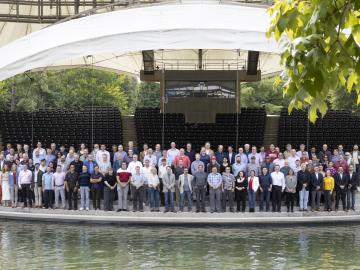
Filter News
Area of Research
- Biology and Environment (67)
- Biology and Soft Matter (1)
- Computational Biology (1)
- Electricity and Smart Grid (1)
- Energy Science (36)
- Fusion and Fission (6)
- Isotopes (2)
- Materials (22)
- Materials for Computing (5)
- National Security (14)
- Neutron Science (10)
- Nuclear Science and Technology (1)
- Quantum information Science (2)
- Supercomputing (44)
News Type
News Topics
- (-) Artificial Intelligence (77)
- (-) Environment (116)
- (-) Grid (32)
- (-) Microscopy (23)
- (-) Nanotechnology (17)
- (-) Polymers (9)
- (-) Simulation (42)
- (-) Space Exploration (13)
- 3-D Printing/Advanced Manufacturing (56)
- Advanced Reactors (12)
- Big Data (45)
- Bioenergy (68)
- Biology (80)
- Biomedical (42)
- Biotechnology (25)
- Buildings (30)
- Chemical Sciences (35)
- Clean Water (16)
- Composites (11)
- Computer Science (111)
- Coronavirus (19)
- Critical Materials (5)
- Cybersecurity (14)
- Education (2)
- Emergency (3)
- Energy Storage (32)
- Exascale Computing (51)
- Fossil Energy (6)
- Frontier (44)
- Fusion (38)
- High-Performance Computing (81)
- Hydropower (6)
- Isotopes (33)
- ITER (4)
- Machine Learning (37)
- Materials (51)
- Materials Science (55)
- Mathematics (8)
- Mercury (7)
- Microelectronics (3)
- Molten Salt (2)
- National Security (60)
- Neutron Science (82)
- Nuclear Energy (66)
- Partnerships (36)
- Physics (34)
- Quantum Computing (35)
- Quantum Science (48)
- Security (16)
- Software (1)
- Statistics (2)
- Summit (40)
- Transportation (30)
Media Contacts

A research team led by the University of Maryland has been nominated for the Association for Computing Machinery’s Gordon Bell Prize. The team is being recognized for developing a scalable, distributed training framework called AxoNN, which leverages GPUs to rapidly train large language models.

The Powerline Conductor Accelerated Testing Facility at ORNL is testing new transmission line technologies to enhance the U.S. power grid's capacity amidst rising demand and climate challenges.

Aditya Sundararajan of ORNL’s Grid Systems Architecture group was elevated to senior status within the Institute of Electrical and Electronics Engineers.

Researchers led by the University of Melbourne, Australia, have been nominated for the Association for Computing Machinery’s 2024 Gordon Bell Prize in supercomputing for conducting a quantum molecular dynamics simulation 1,000 times greater in size and speed than any previous simulation of its kind.

To bridge the gap between experimental facilities and supercomputers, experts from SLAC National Accelerator Laboratory are teaming up with other DOE national laboratories to build a new data streaming pipeline. The pipeline will allow researchers to send their data to the nation’s leading computing centers for analysis in real time even as their experiments are taking place.

ORNL researchers were honored with a prestigious ACE Award for Composites Excellence by the American Composites Manufacturers Association. The team won the “innovation in green composites design” prize for creating a fully recyclable, lightweight wind turbine blade tip that incorporates low-cost carbon fiber and conductive coating for enhanced protection against lightning strikes.

Prasanna Balprakash, director of AI programs for ORNL, discussed advancing climate and weather research through high performance computing and artificial intelligence as part of a September 18 panel for the United States Senate.

The Smoky Mountain Computational Sciences and Engineering Conference, or SMC24, entered its third decade with the 21st annual gathering in East Tennessee.

A new Global Biomass Resource Assessment developed by ORNL scientists gathered data from 55 countries resulting in a first-of-its kind compilation of current and future sustainable biomass supply estimates around the world.

The Oak Ridge Leadership Computing Facility welcomed users to an interactive meeting at the Department of Energy’s Oak Ridge National Laboratory from Sept. 10–11 for an opportunity to share achievements from the OLCF’s user programs and highlight requirements for the future.


